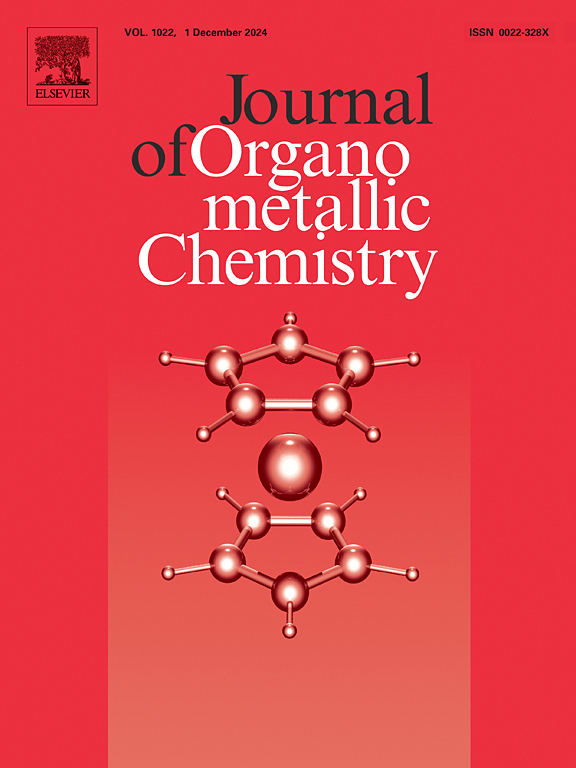Copper (II) oxide immobilized chitosan-alginate modified magnetic bio-nanocatalyst for CN and CC couplings
IF 2.1
3区 化学
Q3 CHEMISTRY, INORGANIC & NUCLEAR
引用次数: 0
Abstract
A novel and efficient copper (II) oxide immobilized chitosan-alginate modified magnetic bio-nanocatalyst (CuO@Fe3O4/CS/Alg) has been designed, synthesized, and employed for C![]() N and C
N and C![]() C coupling reactions. Various spectroscopic and microscopic techniques were used to characterize the CuO@Fe3O4/CS/Alg bio-nanocatalyst. The catalytic activity of CuO@Fe3O4/CS/Alg has been explored for Chan-Lam and Suzuki-Miyaura coupling reactions under various reaction conditions. A group of substituted biaryls and secondary aryl amines has been synthesized with 80 to 94 % yields. The heterogeneity of the bio-nanocatalyst was examined using a hot filtration test and a reusability study. The bio-nanocatalyst exhibited effective saturation magnetization (56.30 emu/g), which facilitates its easy separation from the reaction mixture by an external magnet. The separated bio-nanocatalyst could be recycled up to six reaction cycles for both the coupling reactions. Eco-benign catalytic system, moderate temperature, and high yields of product in short reaction time are the key features of the present protocol.
C coupling reactions. Various spectroscopic and microscopic techniques were used to characterize the CuO@Fe3O4/CS/Alg bio-nanocatalyst. The catalytic activity of CuO@Fe3O4/CS/Alg has been explored for Chan-Lam and Suzuki-Miyaura coupling reactions under various reaction conditions. A group of substituted biaryls and secondary aryl amines has been synthesized with 80 to 94 % yields. The heterogeneity of the bio-nanocatalyst was examined using a hot filtration test and a reusability study. The bio-nanocatalyst exhibited effective saturation magnetization (56.30 emu/g), which facilitates its easy separation from the reaction mixture by an external magnet. The separated bio-nanocatalyst could be recycled up to six reaction cycles for both the coupling reactions. Eco-benign catalytic system, moderate temperature, and high yields of product in short reaction time are the key features of the present protocol.

铜(II)氧化物固定化壳聚糖-海藻酸盐修饰的CN和CC偶联磁性生物纳米催化剂
设计合成了一种新型高效的铜(II)氧化物固定化壳聚糖-海藻酸盐改性磁性生物纳米催化剂(CuO@Fe3O4/CS/Alg),并将其用于CN和CC的偶联反应。利用各种光谱和显微技术对CuO@Fe3O4/CS/Alg生物纳米催化剂进行了表征。考察了CuO@Fe3O4/CS/Alg在不同反应条件下对Chan-Lam和Suzuki-Miyaura偶联反应的催化活性。合成了一组取代的双芳基和仲芳基胺,收率为80 ~ 94%。采用热过滤试验和可重复使用性研究考察了生物纳米催化剂的非均质性。该生物纳米催化剂具有有效的饱和磁化强度(56.30 emu/g),易于通过外部磁体从反应混合物中分离。分离后的生物纳米催化剂可在两种偶联反应中循环使用6次。催化体系生态友好、反应温度适中、反应时间短、产物收率高是本方案的主要特点。
本文章由计算机程序翻译,如有差异,请以英文原文为准。
求助全文
约1分钟内获得全文
求助全文
来源期刊

Journal of Organometallic Chemistry
化学-无机化学与核化学
CiteScore
4.40
自引率
8.70%
发文量
221
审稿时长
36 days
期刊介绍:
The Journal of Organometallic Chemistry targets original papers dealing with theoretical aspects, structural chemistry, synthesis, physical and chemical properties (including reaction mechanisms), and practical applications of organometallic compounds.
Organometallic compounds are defined as compounds that contain metal - carbon bonds. The term metal includes all alkali and alkaline earth metals, all transition metals and the lanthanides and actinides in the Periodic Table. Metalloids including the elements in Group 13 and the heavier members of the Groups 14 - 16 are also included. The term chemistry includes syntheses, characterizations and reaction chemistry of all such compounds. Research reports based on use of organometallic complexes in bioorganometallic chemistry, medicine, material sciences, homogeneous catalysis and energy conversion are also welcome.
The scope of the journal has been enlarged to encompass important research on organometallic complexes in bioorganometallic chemistry and material sciences, and of heavier main group elements in organometallic chemistry. The journal also publishes review articles, short communications and notes.
 求助内容:
求助内容: 应助结果提醒方式:
应助结果提醒方式:


